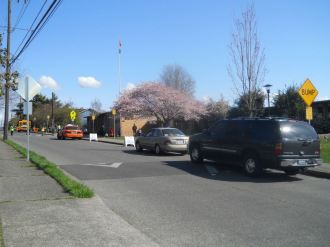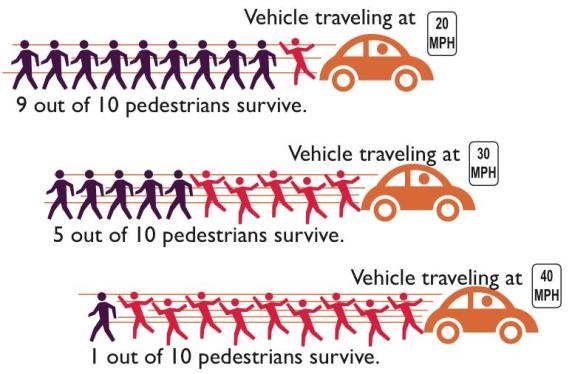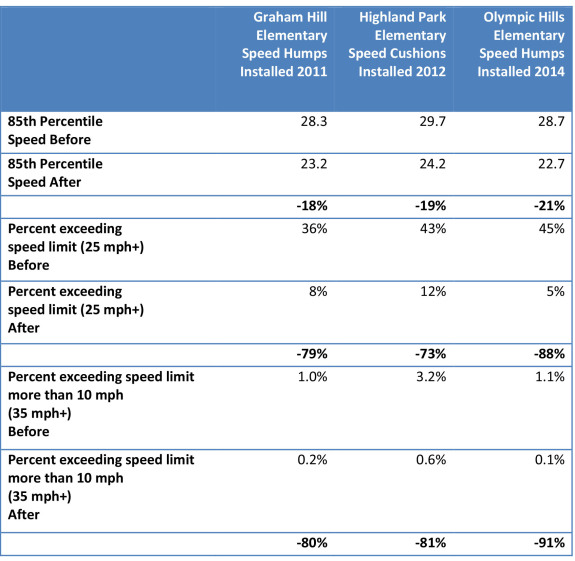
Seattle started installing speed humps as part of neighborhood greenways and Safe Routes to School projects a couple years ago. And wisely, SDOT staff measured speed data before the speed humps were installed so they could see whether the humps are actually effective.
The answer: Oh yes.
Total speeding on the streets near three elementary schools dropped between 79 – 88 percent after speed humps were installed, and high-end speeding was nearly eradicated according to SDOT.
That’s why speed humps are sometimes referred to as “sleeping police officers,” though they cost a lot less and stay on duty forever.
Car speed is among the most important factors that determine how serious a person is injured in a collision and, of course, whether the collision occurs in the first place:
 Speed “humps” are different from the speed “bumps” you encounter sometimes in parking lots. The humps are more gradual and are not meant to bring people to a nearly complete stop. If you are driving around 20 mph or below, you will not need to adjust your speed to go over them. If you are driving faster than that, however, you will need to slow or face a jolt. And unlike with some speed bumps, the speed humps are not so sudden that they are likely to cause someone on a bike to crash.The city’s speed humps will save lives, and they will prevent many people from serious and sometimes debilitating injuries. But they will also make neighborhood streets places where people of all ages can live, have fun and get around on foot and bike. Today, too many streets are dangerous places that we avoid, but it doesn’t need to be that way.We have the tools to make our streets safer, and the speed hump is a powerful one. We just need to invest in them.
Speed “humps” are different from the speed “bumps” you encounter sometimes in parking lots. The humps are more gradual and are not meant to bring people to a nearly complete stop. If you are driving around 20 mph or below, you will not need to adjust your speed to go over them. If you are driving faster than that, however, you will need to slow or face a jolt. And unlike with some speed bumps, the speed humps are not so sudden that they are likely to cause someone on a bike to crash.The city’s speed humps will save lives, and they will prevent many people from serious and sometimes debilitating injuries. But they will also make neighborhood streets places where people of all ages can live, have fun and get around on foot and bike. Today, too many streets are dangerous places that we avoid, but it doesn’t need to be that way.We have the tools to make our streets safer, and the speed hump is a powerful one. We just need to invest in them.









Comments
26 responses to “Seattle’s speed humps cut excessive speeding 80 – 90%”
We took the speed hump design from Portland for our greenways. Thanks to PBOT for leading the way on this!
Obviously, Seattle has used speed humps (and bumps) before, but the quality and design was all over the place. For example, here’s 1st Ave NE: https://twitter.com/NEGreenways/status/488164553335664640 . That one’s for a 15mph speed limit. On a street with no sidewalk.
I really don’t like the speed humps on the greenways. They are the primary reason that I don’t bike on the greenways. There need to be cut outs for bicyclists.
I hate that kind of speed hump (full width, as shown in the photo) when riding a bike. I much prefer the kind that have breaks in the hump for cyclists (like can be seen in several places in West Seattle, such as Beach Drive SW, Erskine Way SW/48th Ave SW, and Fairmont Ave SW). The breaks let the cyclist ride between the humps and not get jolted going over them. The breaks are situated so drivers of cars can’t avoid the speed hump.
Fairmont is an excellent example of a place where a full width speed hump would be especially dangerous for cyclists and probably motorcycles too. Between Fairmont’s steep downhill grade, curves and wet leaves in the Fall, a full width speed hump would be hidden or a dangerous obstacle to negotiate on two wheels. Thankfully, the city put the speed humps in on Fairmont with the breaks.
I realize the city will be wanting to put in more speed humps, but please take into account bicycles and make sure they have the breaks.
Putting a speed bump on a slippery curve would be kind of stupid and probably should have a slot for bicycles to get through if you are going to do it. The rest of the time a full width speed bump is fine if the choice is between that and no speed bump at all. I think the occassional speed bump is great unless I have a load of groceries.
I sometimes ride a well-laden bike, sometimes on greenways. In my experience, most all speed humps without cut-outs or pass-throughs can be problematic, particularly if other conditions are less than ideal.
#comment-645271, November 4, 2014 at 9:49 am, sdv said,
speed humps on the greenways. They are the primary reason that I don’t bike on the greenways. There need to be cut outs for bicyclists.
#comment-645124. November 3, 2014 at 1:43 pm, Allan said,
I think the [occasional] speed bump is great unless I have a load of groceries.
Yes, quite. Bike facilities are s’posed to be for AAA–all ages and abilities. That should include carrying groceries. Or a child. Comfortably.
#comment-645138, November 3, 2014 at 3:45 pm, Josh said,
but they can be a comfort issue.
If we truly want to include AAA, facilities need to be appealing and comfortable for most everyone, including those with laden bikes..
#comment-645302, November 4, 2014 at 12:41 pm, sdv said,
I don’t ride super fast, but I ride too fast for those speed humps. The more humps I have to go over, the less likely I am to ride.
I also. Though that is, the less likely I am to ride a route that has unmitigated humps.
and sdv said,
if I have to use Westlake full of speed humps, I’ll stop riding.
BTW, are speed humps code-acceptable within bicycle facilities?
Elsewhere, on September 2, 2014 at 1:29 pm, Josh wrote,
The 2014 Bicycle Master Plan Update adopting resolution made a binding commitment that SDOT must comply with current local, state, and national standards and guidance for BMP facilities. […]
City Council resolutions are supposed to have the force of law within the city. [ <a href="http://www.seattlebikeblog.com/2014/09/02/salomon-safety-changes-need-to-be-part-of-roosevelt-repaving-project/#comment-638777" title="Salomon, SBB, ‘Safety changes need to be part’, #comment-638777″> ]
Tom wrote,
Seattle started installing speed humps as part of neighborhood greenways and Safe Routes to School projects a couple years ago.
The explicit purpose of Greenways is making more urban space–public right of ways–more available for more uses and more people, and Safe Routes to School to make bicycling more fun for kids and and more practical for parents. Making facilities more appealing is one of the keys. SDOT needs to refine their speed hump installation standards accordingly.
Not to disagree with you about what is preferable for cyclists, but just wanted to point out that those gaps aren’t actually intended to make it smoother for cyclists, they’re used for drainage, so that stormwater doesn’t pool on the uphill face of the speed hump and prematurely degrade the asphalt. That’s why you typically see them on steeper (>5% grade) roads.
Some jurisdictions intentionally provide cyclist passages through speed humps, regardless of drainage needs.
In other cases, some speed tables used as raised crosswalks intentionally *don’t* have clear passage for cyclists, since cyclists as well as drivers should be crossing slowly and prepared to stop.
When riding over humps like these it helps to give a pull up on the bars when you first hit the bump and an equal push down as you go over the other edge. Makes the transition a lot more comfortable.
Sounds great in theory. I rode a mountain bike off road for many years and am familiar with the technique. However, my mountain bike had front suspension for such obstacles. That said, in practice – while the cyclist is dealing with inattentive drivers pulling out of driveways, jaywalking pedestrians, cars tailgating because they are unable to pass, cracked and broken pavement, broken glass and metal on the road, steep grades up and down hills, and a myraid of other road hazards, I think making urban cyclist negotiate speed humps is ill conceived at best. Therefore, please put in the bike breaks in the humps.
It doesn’t have anything to do with “theory”, it has to do with not taking the bump directly on the nose. And really if all those scary things you mentioned PLUS a speedbump are too much to handle it’s probably better to stay home where its safe anyway.
Speed humps are a great way to make excessive speeds uncomfortable. They should be installed for high-car traffic areas as well as bike lanes where speed should be limited, including the Westlake path being designed.
ChefJoe, I don’t understand why we want to slow bicyclists down to such slow speeds. I don’t ride super fast, but I ride too fast for those speed humps. The more humps I have to go over, the less likely I am to ride. It’s too bad because my company is moving to South Lake Union next year…if I have to use westlake full of speed humps, I’ll stop riding.
This technique works for cars as well, slam on your brakes just before the speed bump, then release, this causes the weight to shift forward, then lift off the front wheels, accellerate as you pass over the speed bump then get off the gas, this causes the weight to again shift off the rear wheels to lift the tail of your car over…. you can easily add 10mph to crossing a speed bump this way…
On the down side, if the suspension hits the steering rods, it will bend them them.. so at your own risk..
Unless I’m going over 20 mph, I don’t find those long, slow speed humps to be a control/safety issue on my bike, but they can be a comfort issue.
Centering a channel through the hump can provide a smoother route for cyclists, encourage a safer lane position, and if it’s done well, it can also improve drainage — I hate speed humps that pond water and road slime on rainy days.
I would encourage the city to add advanced warning markings on streets that tend to accumulate leaves — that gives cyclists (and motorists) more warning of the hump if the hump’s own markings are obscured. See http://mutcd.fhwa.dot.gov/htm/2009/part3/fig3b_31_longdesc.htm
I agree with Josh. The newer gradual humps are no impediment to a bike at 20 mph and special bump techniques are not needed. Augsuburg: The old humps on Beach Dr are useless now. The drivers have figured out how to take them at speed. The humps on Fairmont are ok; the cuts for bikes are hard to see if you are unfamiliar with them.
In the past the fire department generally opposed speed bumps. Maybe they are happier with the humps we are seeing now.
I agree, I have several of these on my way home and I don’t notice them at all on a bicycle. Partly it’s because they are older and the cars & trucks & buses driving over them have flattened them out some. In car, it’s best if you drive the speed limit over them and that’s what they are for..
I vastly prefer these sort of speed humps vs traffic cameras as a way to encourage folks to slow down.
When I was in Egypt this was the only thing that stopped cars in New Cairo.
I would look for these speed humps to cross the street.
If there was no speed hump, I had to play frogger.
For those not aware they use roundabouts instead of stopping. If traffic wasn’t bad you never had to stop.
I like these were they have some flatness on top.
http://www.trafficsystemswest.com.au/images/Speed%20Humps/Speed%20hump%20Crosswalk.jpg
There are a couple big ones on 82nd st between 25th and 30th aves ne and it is a big downhill. I routinely hit them at 25-30mph with no issues on my bike, but have to go much slower in a car. I think they are great speed control devices, but they need to be well marked with signs and reflective paint.
The 85% speed test really shouldn’t be applicable to neighborhood areas. The test throws out the highest 7.5% recorded speeds (and the lowest 7.5%). These high speeds are what kill people and what a good design would protect the neighborhood from
You still need both tests — some neighborhoods have streets wide enough that the 85% speed is clearly a threat to pedestrians, 35+ mph. In those cases, you’re not dealing with reining-in a few percent of speeding outliers, but with lowering everyone’s speed.
The other reason for running the 85% test, on streets where the average speed is already safe, is to check whether the traffic calming is unintentionally creating significant traffic delays.
If you rein in the outliers with little or no impact on the 85% speed, you can refute the inevitable claims that you’re “slowing everyone down” for the sake of a few pedestrians — you have the data to expose the selfish speeder as an outlier, not a respresentative of the community’s experience.
The ones on the 57th NW corridor in Ballard are great. They’ve not only helped slow the traffic; but also give another visual cue to drivers that there are bikes present.
And they’re easily ridable even on my skinny-tire road whip. We’re not talking Mexican topes here…
Can we now get these on 65th in Ballard? I live near the corner of it and 24th Ave., and it’s a nightmare to get into your own car or ride in the street (I ride the sidewalk until I get off of the street on my commute to downtown). Apparently it’s an “arterial” so it’s hands off for traffic mitigation, which, in my opinion, is utter bullshit. Children live on my street and go to school there, so why can’t we get a couple of speed bumps to at least make people more aware instead of racing at 50 mph to get through the next light? It sucks.
I have though about getting a pick axe and digging my own potholes but I prefer to stay out of jail. It is nice to imagine doing it though.
[…] humps: Excessive speeding is cut up to 80%-90% in Seattle where speed humps have been […]
[…] NW 58th Street greenway uses speed humps to slow cars through some neighborhood stretches. And the major intersection with 15th Avenue NW includes this set of traffic diverters that force […]